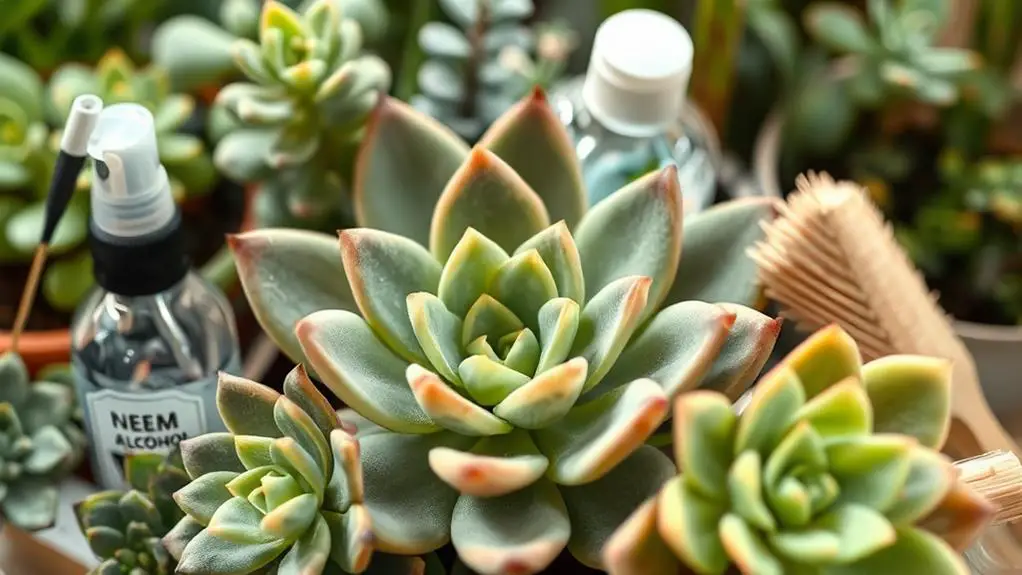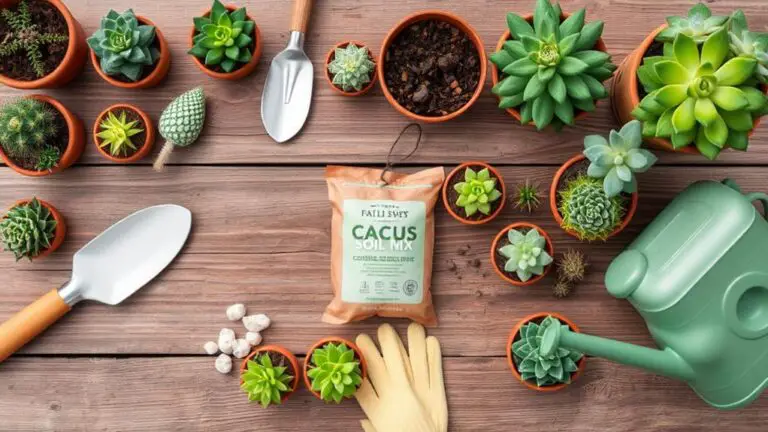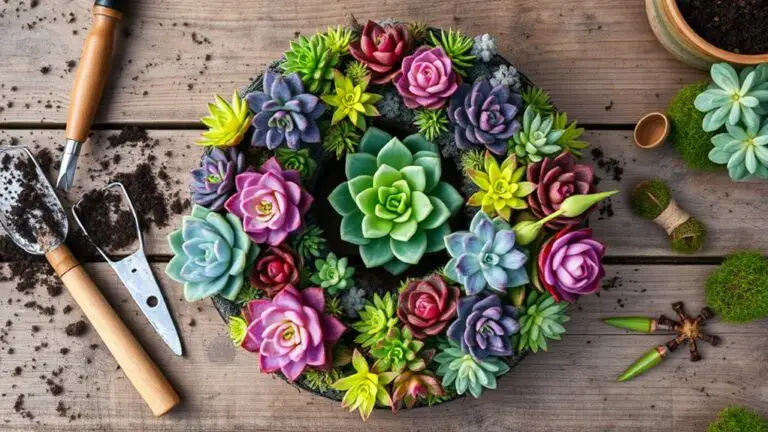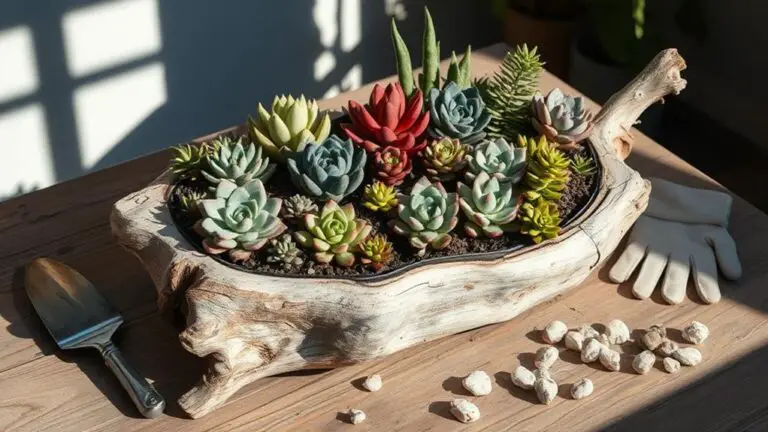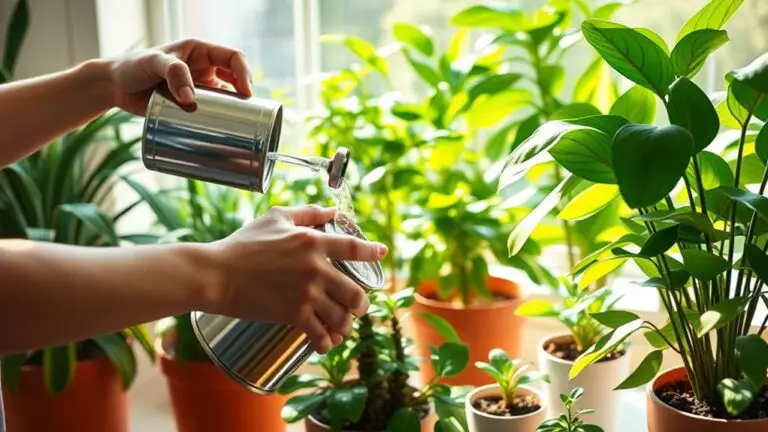7 Effective Methods to Get Rid of Mealy Bugs on Succulents
Dealing with mealybugs on your succulents can be frustrating, but there are effective strategies you can use to reclaim your plants. You'll need to start by identifying the infestation and isolating the affected plants to prevent the pests from spreading. Once isolated, a strong water stream can dislodge many of the bugs. But that's just the beginning. To guarantee thorough removal, you can apply 70% isopropyl rubbing alcohol and utilize a neem oil solution. Curious about natural predators or how often to repeat treatments to keep your succulents healthy? Let's explore these methods in more detail.
Identify Mealybug Infestation
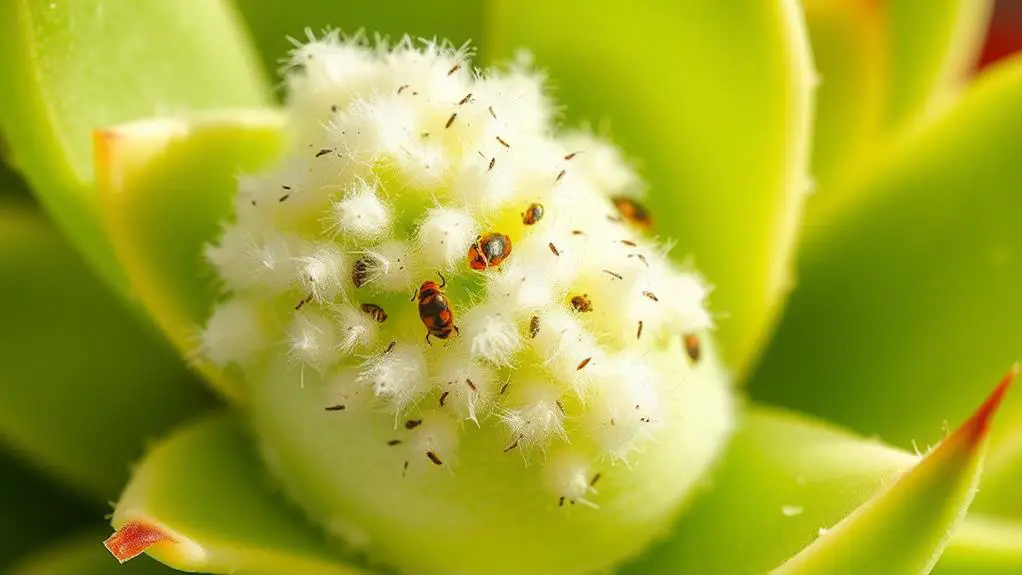
When it comes to identifying a mealybug infestation on your succulents, you'll want to keep an eye out for telltale signs. Mealybugs often appear as a white, cotton-like substance on the leaves and stems of your plants. This makes them relatively easy to spot, especially if you know what you're looking for.
Infestations usually occur near new growth, so check there first. You might notice sticky residue on the leaves, shriveling leaves, or even leaves that drop when touched. These are all clear indicators that mealybugs might've made themselves at home.
However, these pests can be tricky to detect because they love hiding in crevices and leaf axils, especially in plants with dense foliage. Regularly monitoring and inspecting your plants is key. During the warmer months, make it a habit to give your succulents a thorough once-over.
Also, keep an eye out for ants. They're attracted to the sweet secretions that mealybugs produce. If you see ants crawling around your plants, it could be a sign of a hidden infestation.
Isolate Infected Plants
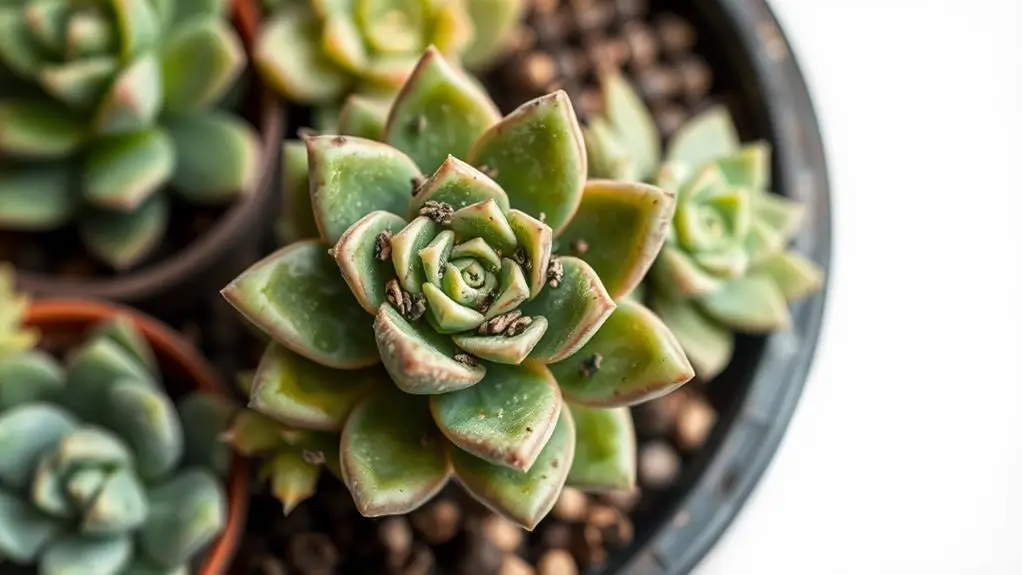
To stop mealybugs from spreading, it's important to isolate any infected plants right away.
Keep the plant in a separate area for 2-3 weeks and regularly check it for signs of pests.
Make sure it's not in direct sunlight, so it can recover without added stress.
Quarantine to Prevent Spread
Quarantining infected plants, besides being essential, helps prevent the rapid spread of mealybugs among your succulents. Move any affected plants to a separate area, away from your healthy succulents. This step is vital in preventing an outbreak.
Keep the quarantined plants isolated for 2-3 weeks to monitor for signs of additional infestations. Here's what you need to do:
- Quarantine infected plants: Relocate them to a different spot in your home or garden. This limits the risk of mealybugs spreading to your other plants.
- Monitor for signs: Check the quarantined plants weekly. Look closely at leaf axils and new growth for visible signs of mealybugs or other pests.
- Avoid cross-contamination: Use separate tools and watering cans for infected and healthy plants. This minimizes the chance of spreading mealybugs by accident.
- Dispose of infested plants: If a plant is severely infested, it's best to properly dispose of it. This protects the rest of your succulent collection from potential outbreaks.
Inspect for Infestation Signs
Identifying mealybug infestations early is essential for maintaining the health of your succulents. To catch these pests before they cause significant damage, you need to inspect succulents regularly. Look for white cottony markings, particularly around new growth and leaf bases, as these are clear signs of a mealybug problem. Regular monitoring helps with early detection, making it easier to control the infestation before it spreads.
When inspecting, don't forget to check for other signs of mealybugs or eggs. Sticky residue, discoloration, or shriveling leaves can indicate a more severe issue. Sometimes, mealybugs can be hard to spot, especially on densely leafed plants. Using a magnifying glass can help you see them better.
If you do find mealybugs, isolate the infected plants immediately. This step is essential to prevent the pests from spreading to your healthy succulents. Female mealybugs can lay up to 600 eggs in a short period, so acting quickly is critical.
Regular monitoring and thorough inspections are your best defenses against these pests. Taking these steps will keep your succulents happy and thriving, ensuring your garden stays beautiful and pest-free.
Rinse With Strong Water Stream
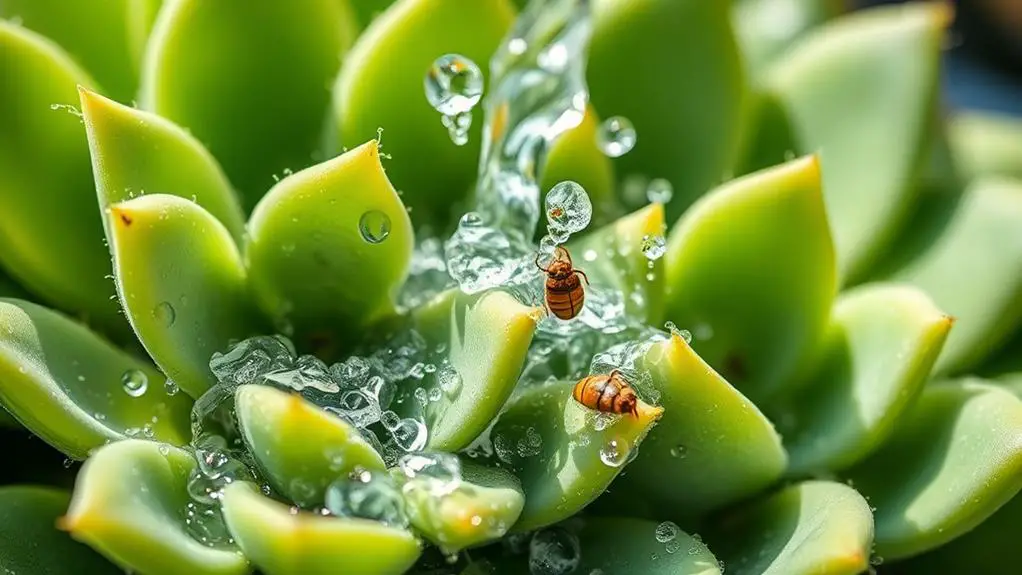
To clean your succulent thoroughly and remove surface bugs, rinse it under a strong stream of water.
Direct the water toward the leaves and stems to guarantee you dislodge those pesky mealybugs.
Make sure the water pressure is strong enough to wash them away without harming your delicate plant.
Clean Plant Thoroughly
Ever wondered how to effectively combat mealybugs on your succulents? One simple and effective method is to rinse infected succulents with a strong stream of water. This method helps you clean the area and notably reduces the mealybug population before applying other treatments.
Here's how to do it:
- Focus on Undersides and Crevices: Mealybugs love hiding in the undersides of leaves and small crevices. Aim the water stream at these areas to guarantee thorough coverage.
- Use Lukewarm Water: It's crucial to use lukewarm water to avoid shocking your succulent. Too cold or too hot water can damage the plant.
- Be Gentle Yet Thorough: While it's important to use a strong stream, be gentle to avoid damaging the delicate leaves. This will help you remove the mealybugs without harming the plant.
- Inspect the Plant After Rinsing: After rinsing, inspect the plant carefully for any remaining mealybugs. This step helps you determine if additional treatments are necessary.
Regular cleaning with water can also help maintain your succulent's health and prevent future infestations.
Remove Surface Bugs
One effective way to tackle mealybugs on your succulents is to rinse them with a strong stream of water. Rinsing helps dislodge these pests from the plant's surface, greatly reducing their population. Use lukewarm water to avoid shocking the plant. Make sure the water reaches all areas, including under leaves and in crevices. This method works best for minor infestations and allows you to remove visible bugs without using chemicals.
When rinsing, focus on the foliage and be careful not to saturate the soil. Too much water in the soil can lead to root rot, which is another problem you don't want. Aim the strong stream of water at the affected areas, making sure to cover all parts of the plant.
After you've finished rinsing, inspect your succulent closely. Look for any remaining mealybugs that might still be hiding. If you find more bugs, consider follow-up treatments to keep your plant healthy.
Rinsing with a strong stream of water is a simple, effective way to protect your succulents from mealybugs. By following these steps, you can maintain a beautiful, pest-free garden.
Apply Rubbing Alcohol
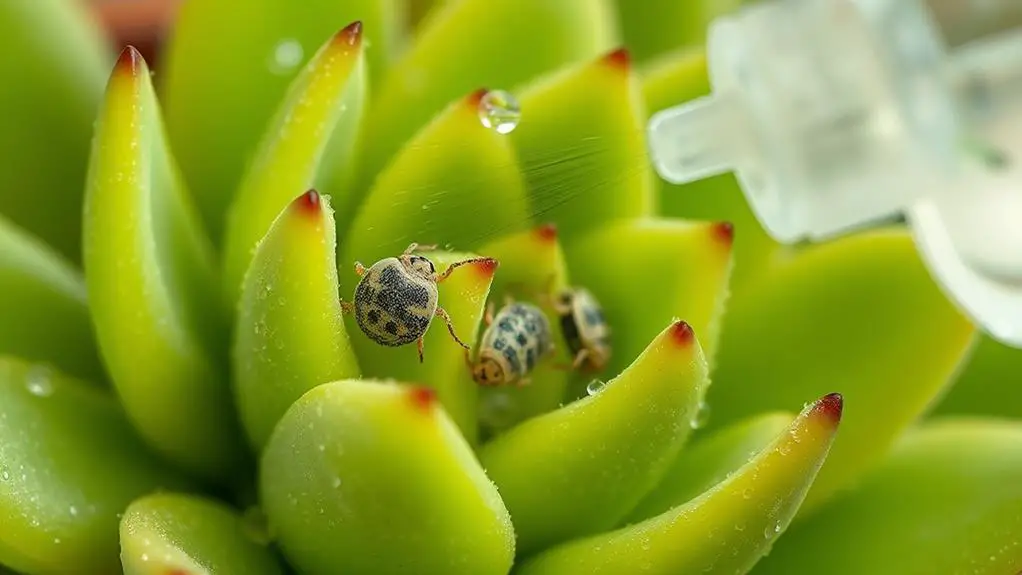
When battling mealybugs on your succulents, applying rubbing alcohol is a highly effective method that you'll find invaluable. It's quick, straightforward, and doesn't leave any nasty residue behind.
Here's how you can use it to get rid of mealybugs:
- Prepare Your Spray Bottle: Fill a spray bottle with 70% isopropyl rubbing alcohol. This concentration is ideal because it kills mealybugs on contact but evaporates quickly, minimizing potential damage to your plants.
- Apply Directly to Affected Areas: Spray the rubbing alcohol directly onto the mealybugs. You can also use a cotton swab dipped in the solution for more precision, especially in hard-to-reach areas.
- Repeat for Severe Infestations: If the infestation gets worse or persists, don't worry. Multiple applications may be necessary to completely eradicate both the adult bugs and their eggs.
- Rinse and Remove Dead Pests: After treating your succulents, rinse them with a strong stream of water. This helps remove dead pests and any remaining alcohol, ensuring your plant stays healthy.
Always test the rubbing alcohol on a small part of the plant first to make sure it won't cause any damage.
With these steps, you'll find tackling mealybugs much more manageable.
Use Neem Oil Solution
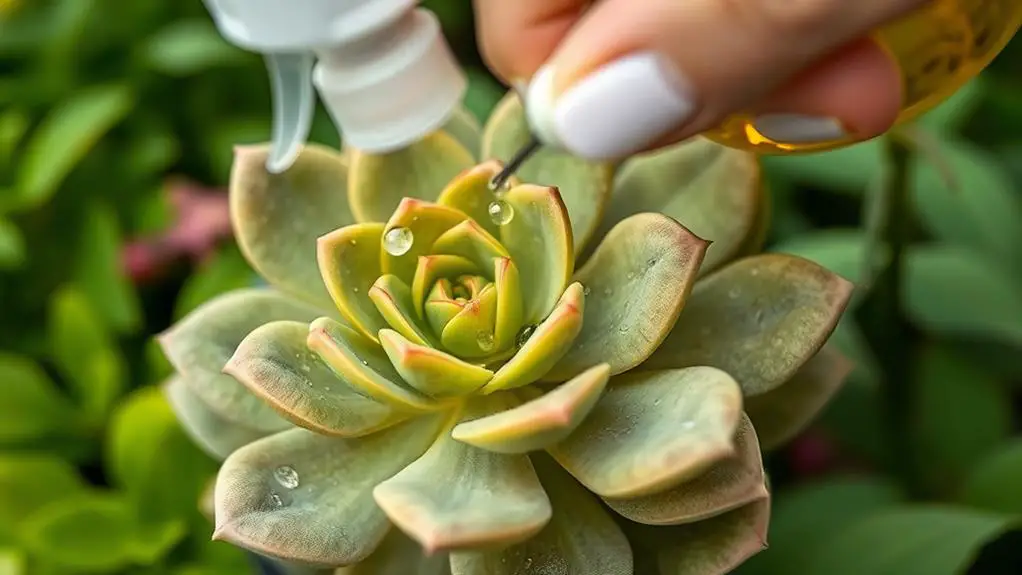
Another effective method for tackling mealybugs on your succulents is using a neem oil solution. Neem oil acts as a natural insecticide that suffocates mealybugs and disrupts their life cycle.
To create the solution, mix neem oil with water and add a few drops of liquid soap. This forms an emulsion that you can spray directly onto the affected areas of your succulents.
It's best to apply this neem oil solution in the early morning or late evening. This timing helps avoid direct sunlight, which can cause leaf burn on treated plants.
Make sure to cover all parts of the plant, including the undersides of leaves where mealybugs often hide.
Reapply the neem oil solution every 7-14 days until you've got the infestation under control and no signs of the pests remain. Consistency is key here.
Regular monitoring of your succulents is essential after treatment. Keep an eye out for any remaining mealybugs so you can address them promptly and prevent a recurrence of the infestation.
Introduce Natural Predators
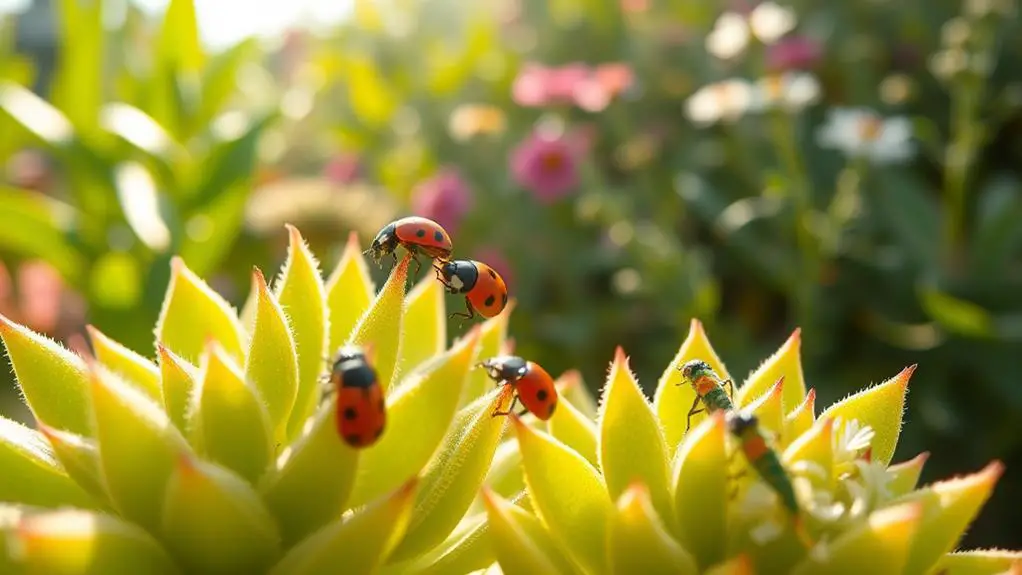
Introducing natural predators into your garden can be an effective strategy for controlling mealybug infestations on your succulents. Ladybugs, in particular, are fantastic allies in your pest control efforts. They can consume up to 50 mealybugs per day, considerably reducing their numbers if you introduce them early in an infestation.
To guarantee success, create an environment that attracts and keeps these helpful insects around.
Here's how you can start:
- Introduce Ladybugs: Release ladybugs into your garden. They love to feast on mealybugs, providing a natural solution to your pest problem.
- Provide Habitat: Make sure your garden has plenty of food and shelter for ladybugs. Planting flowers like marigolds and dill can help.
- Consider Other Predators: Lacewings and parasitic wasps also prey on mealybugs. Introducing these insects can help maintain effective pest control.
- Regular Monitoring: Keep an eye on your garden to verify that your natural predators are thriving and keeping the mealybug population under control.
Monitor and Repeat Treatment
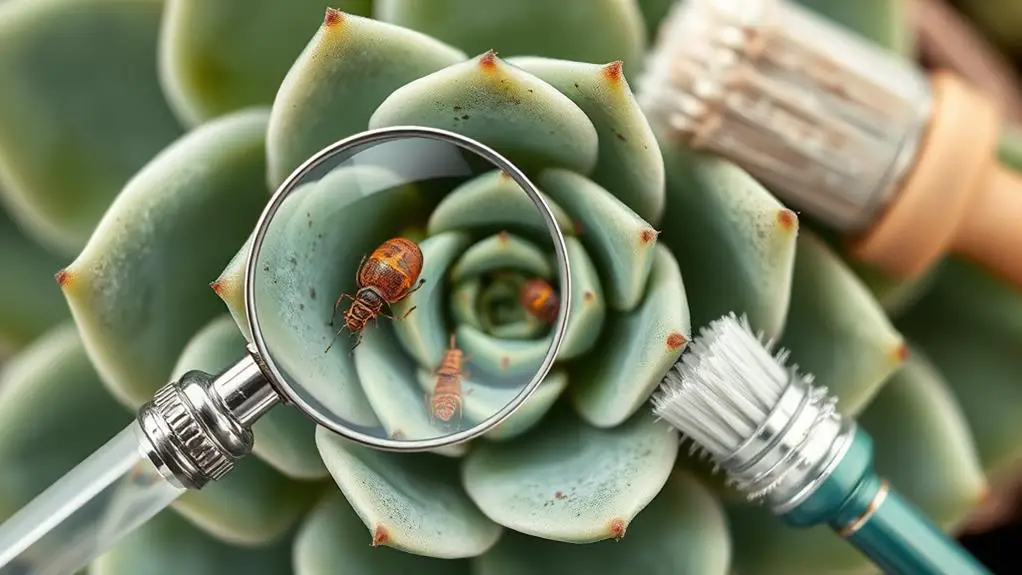
Vigilance is key to keeping mealybugs at bay on your succulents. You need to regularly inspect your plants at least once a week. Look for signs of mealybugs, like cottony white masses and leaf deformities. Catching an infestation early makes it easier to manage.
After your initial treatment with isopropyl alcohol or neem oil, closely monitor the plants. Check both the upper and lower surfaces of the leaves, as well as any crevices where mealybugs might hide. If you spot any remaining mealybugs, reapply the treatment every 7 to 10 days. Consistency is vital to guarantee the mealybugs are fully eradicated.
If you notice the mealybugs coming back even after treatment, don't get discouraged. Re-evaluate your treatment method or frequency. Sometimes, adjusting how often you treat the plants can make a substantial difference.
Keeping a consistent monitoring routine not only helps you detect mealybugs but also contributes greatly to the overall health of your succulents. A healthy plant is less likely to suffer from future infestations.
Stay diligent, and your succulents will thrive, free from the nuisance of mealybugs.
Frequently Asked Questions
Can Mealybugs Harm Humans or Pets?
You don't need to worry about mealybugs harming you or your pets. They're mostly a nuisance to plants, not people or animals. Focus on protecting your succulents, and you'll keep your home environment safe and healthy.
What Are the Signs of Mealybug Damage on Succulents?
You'll notice white, cotton-like patches on your succulents, along with yellowing or wilting leaves. Mealybugs also leave behind a sticky residue called honeydew, which can attract ants and cause further plant damage.
How Long Does It Take to Eradicate Mealybugs?
It typically takes a few weeks to completely eradicate mealybugs. You'll need to consistently apply treatments and monitor your plants closely. Patience is key, as multiple applications are often necessary to guarantee all bugs are gone.
Should I Remove Heavily Infested Succulent Leaves?
Yes, you should remove heavily infested succulent leaves. Doing so prevents the spread of mealybugs to healthier parts of the plant. Act quickly and dispose of the infested leaves to protect your succulent's overall health.
Can Mealybugs Spread to Other Indoor Plants?
Yes, mealybugs can spread to other indoor plants. You'll need to isolate the affected plant immediately to prevent further infestation. Consistently check your other plants for signs of mealybugs and take action if you spot any.
Conclusion
You've got this! By following these steps, you'll effectively combat mealybugs on your succulents. Remember to keep an eye on your plants and act quickly if you see any signs of these pesky bugs. Regular treatment and good plant care are key. Don't forget to isolate infected plants and reapply treatments every 7 to 10 days. With patience and persistence, your succulents will thrive, and those mealybugs won't stand a chance! Happy gardening!

